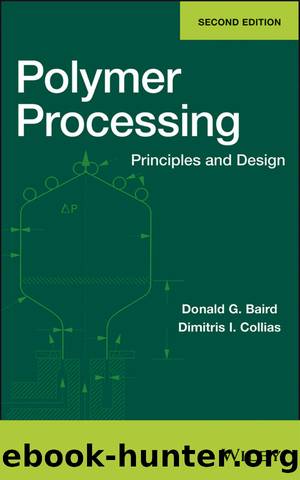Polymer Processing by Donald G. Baird & Dimitris I. Collias

Author:Donald G. Baird & Dimitris I. Collias [Baird, Donald G. & Collias, Dimitris]
Language: eng
Format: epub
Publisher: Wiley
Published: 2014-03-08T00:00:00+00:00
6.5.2 Liquid–Liquid Dispersion
The dispersion of one liquid into another is a very important mixing process for polymer blends. As mentioned in the introduction of this chapter, dispersion of small rubber particles in PS is vital for the improvement of the impact properties of PS. Because the blending takes place in the molten state, understanding of the phenomena in a typical liquid–liquid dispersion is essential for the polymer blend business. However, a lack of agreement between the theoretical predictions and the experimental data in polymer blends should not always be used to discredit the theory, as relaxation processes can alter the structure as the blend goes from the molten to the frozen state.
Liquid–liquid dispersion is characterized by two phases, the dispersed and the continuous. The physical parameters of the two phases affecting a liquid–liquid dispersion are viscosity, elasticity, interfacial tension, solubility, and diffusion rate. For solubility, the system is considered as miscible, immiscible, or partially miscible. Interfacial tension is lowest for miscible systems and highest for immiscible systems. As mentioned in Chapter 4, all high molecular substances have a diffusion coefficient, , of about 10−12 to 10−14 cm2/s. Consequently, the diffusion rates in molten polymer systems are extremely small, and the relative penetration depths in the time scale of the blending process are extremely small.
Both the dispersed and the continuous phases are fed into the blending or compounding equipment in the form of pellets. The deformation and the dispersion starts after heating both components to temperatures above their melting point. Similarly to the dispersion of agglomerates, the hydrodynamic force is the deforming and disruptive force and the interfacial tension force is the cohesive force of the dispersed phase. The ratio of these two forces or stresses is called the Capillary (or Weber) Number, Ca:
(6.183)
where R is the characteristic length (radius) of the dispersed phase and μc is the viscosity of the continuous phase, and γis the interfacial tension. The initial characteristic length of the dispersed phase is the pellet radius, which is not large enough for interfacial forces, γ/R, to play any role at that stage. For example, a dispersed system with characteristic length 2 mm, interfacial tension 30 mN/m, continuous phase viscosity 100 Pa·s, and subjected to a shear rate of 100 s−1 experiences a viscous disruptive stress of 10, 000 Pa while the resisting interfacial tension stress is only 15 Pa.
As blending proceeds, the characteristic length of the dispersed phase decreases to the point of equilibrium between the disruptive hydrodynamic and cohesive interfacial tension forces. Of course, during the blending process, dispersed droplets come in contact with each other and may coalesce, so that coalescence and breakup are two competitive mechanisms in polymer blends. In the final blending stages miscible and immiscible systems behave differently. On the one hand, in miscible systems homogenization is achieved on a very small scale, possibly the molecular scale, if sufficient time is allowed. On the other hand, immiscible systems exhibit a two-phase structure whose characteristics depend on the physical parameters of both polymer phases.
Download
This site does not store any files on its server. We only index and link to content provided by other sites. Please contact the content providers to delete copyright contents if any and email us, we'll remove relevant links or contents immediately.
| Automotive | Engineering |
| Transportation |
Whiskies Galore by Ian Buxton(40330)
Introduction to Aircraft Design (Cambridge Aerospace Series) by John P. Fielding(32338)
Small Unmanned Fixed-wing Aircraft Design by Andrew J. Keane Andras Sobester James P. Scanlan & András Sóbester & James P. Scanlan(32141)
Craft Beer for the Homebrewer by Michael Agnew(17446)
Turbulence by E. J. Noyes(7039)
The Complete Stick Figure Physics Tutorials by Allen Sarah(6638)
Kaplan MCAT General Chemistry Review by Kaplan(6053)
The Thirst by Nesbo Jo(5785)
Bad Blood by John Carreyrou(5769)
Learning SQL by Alan Beaulieu(5411)
Weapons of Math Destruction by Cathy O'Neil(5036)
Man-made Catastrophes and Risk Information Concealment by Dmitry Chernov & Didier Sornette(4735)
iGen by Jean M. Twenge(4702)
Digital Minimalism by Cal Newport;(4540)
Life 3.0: Being Human in the Age of Artificial Intelligence by Tegmark Max(4507)
Audition by Ryu Murakami(4099)
1,001 ASVAB Practice Questions For Dummies by Powers Rod(4038)
Electronic Devices & Circuits by Jacob Millman & Christos C. Halkias(4027)
Pale Blue Dot by Carl Sagan(4001)
